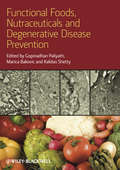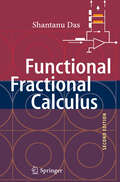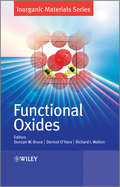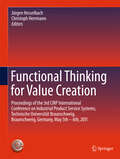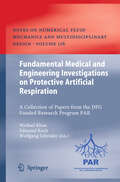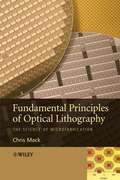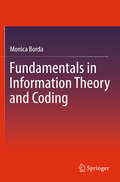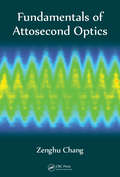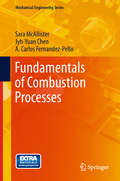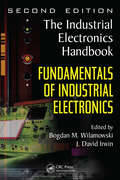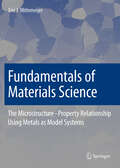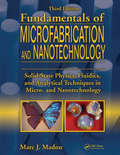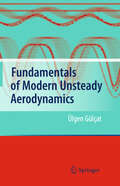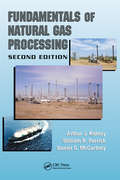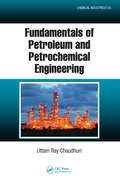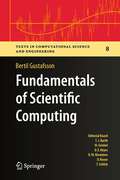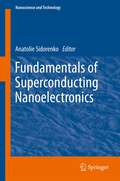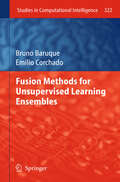- Table View
- List View
Functional Foods, Nutraceuticals, and Degenerative Disease Prevention
by Gopinadhan Paliyath Marica Bakovic Kalidas ShettyFunctional Foods, Nutraceuticals and Degenerative Disease Prevention is a compilation of different segments of functional foods and nutraceuticals focusing on their mechanism of action in the human body leading to disease prevention. Numerous chapters deal with different functional foods in terms of their efficacy, highlighting the mechanism of action of their ingredients. The book focuses on the biochemistry and molecular biology of the disease prevention process rather than simply compiling the benefits of functional foods and nutraceuticals. Aimed primarily at an audience comprised of researchers, industry professionals, food scientists, medical professionals and graduate level students, Functional Foods, Nutraceuticals and Degenerative Disease Prevention offers a mechanism-based interpretation for the effect of nutraceuticals within the human body. Ultimately, the discussion of the biological effects of a variety of functional foods will provide a wholesome approach to the maintenance of health through judicious choice of functional foods.
Functional Fractional Calculus
by Shantanu DasWhen a new extraordinary and outstanding theory is stated, it has to face criticism and skeptism, because it is beyond the usual concept. The fractional calculus though not new, was not discussed or developed for a long time, particularly for lack of its application to real life problems. It is extraordinary because it does not deal with ‘ordinary’ differential calculus. It is outstanding because it can now be applied to situations where existing theories fail to give satisfactory results. In this book not only mathematical abstractions are discussed in a lucid manner, with physical mathematical and geometrical explanations, but also several practical applications are given particularly for system identification, description and then efficient controls. The normal physical laws like, transport theory, electrodynamics, equation of motions, elasticity, viscosity, and several others of are based on ‘ordinary’ calculus. In this book these physical laws are generalized in fractional calculus contexts; taking, heterogeneity effect in transport background, the space having traps or islands, irregular distribution of charges, non-ideal spring with mass connected to a pointless-mass ball, material behaving with viscous as well as elastic properties, system relaxation with and without memory, physics of random delay in computer network; and several others; mapping the reality of nature closely. The concept of fractional and complex order differentiation and integration are elaborated mathematically, physically and geometrically with examples. The practical utility of local fractional differentiation for enhancing the character of singularity at phase transition or characterizing the irregularity measure of response function is deliberated. Practical results of viscoelastic experiments, fractional order controls experiments, design of fractional controller and practical circuit synthesis for fractional order elements are elaborated in this book. The book also maps theory of classical integer order differential equations to fractional calculus contexts, and deals in details with conflicting and demanding initialization issues, required in classical techniques. The book presents a modern approach to solve the ‘solvable’ system of fractional and other differential equations, linear, non-linear; without perturbation or transformations, but by applying physical principle of action-and-opposite-reaction, giving ‘approximately exact’ series solutions.Historically, Sir Isaac Newton and Gottfried Wihelm Leibniz independently discovered calculus in the middle of the 17th century. In recognition to this remarkable discovery, J.von Neumann remarked, “…the calculus was the first achievement of modern mathematics and it is difficult to overestimate its importance. I think it defines more equivocally than anything else the inception of modern mathematical analysis which is logical development, still constitute the greatest technical advance in exact thinking.”This XXI century has thus started to ‘think-exactly’ for advancement in science & technology by growing application of fractional calculus, and this century has started speaking the language which nature understands the best.
Functional Oxides (Inorganic Materials Series #12)
by Duncan W. Bruce Dermot O’Hare Richard I. WaltonFunctional oxides have a wide variety of applications in the electronic industry. The discovery of new metal oxides with interesting and useful properties continues to drive much research in chemistry, physics, and materials science. In Functional Oxides five topical areas have been selected to illustrate the importance of metal oxides in modern materials chemistry: Noncentrosymmetric Inorganic Oxide Materials Geometrically Frustrated Magnetic Materials Lithium Ion Conduction in Oxides Thermoelectric Oxides Transition Metal Oxides - Magnetoresistance and Half-Metallicity The contents highlight structural chemistry, magnetic and electronic properties, ionic conduction and other emerging areas of importance, such as thermoelectricity and spintronics. Functional Oxides covers these complex concepts in a clear and accessible manner providing an excellent introduction to this broad subject area.
Functional Thinking for Value Creation: Proceedings of the 3rd CIRP International Conference on Industrial Product Service Systems, Technische Universität Braunschweig, Braunschweig, Germany, May 5th - 6th, 2011
by Jürgen Hesselbach Christoph HerrmannAfter the IPS² conferences in Cranfield and Linköping in 2009 and 2010 the 3rd CIRP International Conference on Industrial Product Service Systems (IPS²) 2011 takes place in Braunschweig, Germany. IPS² itself is defined as “an integrated industrial product and service offering that delivers value in use”. The customers expect comprehensive solutions, which are adapted to their individual needs. IPS² offers the possibility to stand out from competition and for long-term customer loyalty. Particularly in times of economic crisis it becomes apparent which producing companies understand to satisfy the needs and requirements of their customers. Especially in this relatively new domain IPS² it will be important to keep track of the whole context and to seek cooperation with other research fields and disciplines. The 3rd CIRP International Conference on Industrial Product Service Systems (IPS²) 2011 serves as a platform for such collaborations and the discussion of new scientific ideas.
Fundamental Medical and Engineering Investigations on Protective Artificial Respiration: A Collection of Papers from the DFG funded Research Program PAR (Notes on Numerical Fluid Mechanics and Multidisciplinary Design #116)
by Michael Klaas Edmund Koch Wolfgang SchröderThis volume contains a collection of papers from the research program “Protective Artificial Respiration (PAR)”. In 2005 the German Research Association DFG launched the research program PAR which is a joint initiative of medicine and fluid mechanics. The main long-term objective of this program is the development of a more protective artificial respiratory system to reduce the physical stress of patients undergoing artificial respiration. To satisfy this goal 11 projects have been defined. In each of these projects scientists from medicine and fluid mechanics do collaborate in several experimental and numerical investigations to improve the fundamental knowledge on respiration and to develop a more individual artificial breathing concept.
Fundamental Principles of Optical Lithography: The Science of Microfabrication
by Chris MackThe fabrication of an integrated circuit requires a variety of physical and chemical processes to be performed on a semiconductor substrate. In general, these processes fall into three categories: film deposition, patterning, and semiconductor doping. Films of both conductors and insulators are used to connect and isolate transistors and their components. By creating structures of these various components millions of transistors can be built and wired together to form the complex circuitry of modern microelectronic devices. Fundamental to all of these processes is lithography, ie, the formation of three-dimensional relief images on the substrate for subsequent transfer of the pattern to the substrate. This book presents a complete theoretical and practical treatment of the topic of lithography for both students and researchers. It comprises ten detailed chapters plus three appendices with problems provided at the end of each chapter. Additional Information: Visiting http://www.lithoguru.com/textbook/index.html enhances the reader's understanding as the website supplies information on how you can download a free laboratory manual, Optical Lithography Modelling with MATLAB®, to accompany the textbook. You can also contact the author and find help for instructors.
Fundamentals in Information Theory and Coding
by Monica BordaThe work introduces the fundamentals concerning the measure of discrete information, the modeling of discrete sources without and with a memory, as well as of channels and coding. The understanding of the theoretical matter is supported by many examples. One particular emphasis is put on the explanation of Genomic Coding. Many examples throughout the book are chosen from this particular area and several parts of the book are devoted to this exciting implication of coding.
Fundamentals of Attosecond Optics
by Zenghu ChangAttosecond optical pulse generation, along with the related process of high-order harmonic generation, is redefining ultrafast physics and chemistry. A practical understanding of attosecond optics requires significant background information and foundational theory to make full use of these cutting-edge lasers and advance the technology toward the n
Fundamentals of Combustion Processes (Mechanical Engineering Series)
by Sara McAllister Jyh-Yuan Chen A. Carlos Fernandez-PelloFundamentals of Combustion Processes is designed as a textbook for an upper-division undergraduate and graduate level combustion course in mechanical engineering. The authors focus on the fundamental theory of combustion and provide a simplified discussion of basic combustion parameters and processes such as thermodynamics, chemical kinetics, ignition, diffusion and pre-mixed flames. The text includes exploration of applications, example exercises, suggested homework problems and videos of laboratory demonstrations
Fundamentals of Industrial Electronics: The Industrial Electronics Handbook
by Bogdan M. Wilamowski J. David IrwinThe Industrial Electronics Handbook, Second Edition combines traditional and newer, more specialized knowledge that will help industrial electronics engineers develop practical solutions for the design and implementation of high-power applications. Embracing the broad technological scope of the field, this collection explores fundamental areas, including analog and digital circuits, electronics, electromagnetic machines, signal processing, and industrial control and communications systems. It also facilitates the use of intelligent systems—such as neural networks, fuzzy systems, and evolutionary methods—in terms of a hierarchical structure that makes factory control and supervision more efficient by addressing the needs of all production components. Enhancing its value, this fully updated collection presents research and global trends as published in the IEEE Transactions on Industrial Electronics Journal, one of the largest and most respected publications in the field. Fundamentals of Industrial Electronics covers the essential areas that form the basis for the field. This volume presents the basic knowledge that can be applied to the other sections of the handbook. Topics covered include: Circuits and signals Devices Digital circuits Digital and analog signal processing Electromagnetics Other volumes in the set: Power Electronics and Motor Drives Control and Mechatronics Industrial Communication Systems Intelligent Systems
Fundamentals of Industrial Electronics: The Industrial Electronics Handbook
by Bogdan M. Wilamowski and J. David IrwinThe Industrial Electronics Handbook, Second Edition combines traditional and newer, more specialized knowledge that will help industrial electronics engineers develop practical solutions for the design and implementation of high-power applications. Embracing the broad technological scope of the field, this collection explores fundamental areas, including analog and digital circuits, electronics, electromagnetic machines, signal processing, and industrial control and communications systems. It also facilitates the use of intelligent systems—such as neural networks, fuzzy systems, and evolutionary methods—in terms of a hierarchical structure that makes factory control and supervision more efficient by addressing the needs of all production components. Enhancing its value, this fully updated collection presents research and global trends as published in the IEEE Transactions on Industrial Electronics Journal, one of the largest and most respected publications in the field. Fundamentals of Industrial Electronics covers the essential areas that form the basis for the field. This volume presents the basic knowledge that can be applied to the other sections of the handbook. Topics covered include: Circuits and signals Devices Digital circuits Digital and analog signal processing Electromagnetics Other volumes in the set: Power Electronics and Motor Drives Control and Mechatronics Industrial Communication Systems Intelligent Systems
Fundamentals of Materials Science: The Microstructure–Property Relationship Using Metals as Model Systems
by Eric J. MittemeijerCheck out the 2nd, new edition, available here: https://link.springer.com/book/10.1007/978-3-030-60056-3 This book offers a strong introduction to fundamental concepts on the basis of materials science. It conveys the central issue of materials science, distinguishing it from merely solid state physics and solid state chemistry, namely to develop models that provide the relation between the microstructure and the properties. The book is meant to be used in the beginning of a materials science and engineering study as well as throughout an entire undergraduate and even graduate study as a solid background against which specialized texts can be studied. Topics dealt with are "crystallography", "lattice defects", "microstructural analysis", "phase equilibria and transformations" and "mechanical strength". After the basic chapters the coverage of topics occurs to an extent surpassing what can be offered in a freshman's course. About the authorProf. Mittemeijer is one of the top scientists in materials science, whose perceptiveness and insight have led to important achievements. This book witnesses of his knowledge and panoramic overview and profound understanding of the field. He is a director of the Max Planck Institute for Metals Research in Stuttgart.
Fundamentals of Microfabrication and Nanotechnology, Three-Volume Set
by Marc J. MadouNow in its third edition, Fundamentals of Microfabrication and Nanotechnology continues to provide the most complete MEMS coverage available. Thoroughly revised and updated the new edition of this perennial bestseller has been expanded to three volumes, reflecting the substantial growth of this field. It includes a wealth of theoretical and practical information on nanotechnology and NEMS and offers background and comprehensive information on materials, processes, and manufacturing options. The first volume offers a rigorous theoretical treatment of micro- and nanosciences, and includes sections on solid-state physics, quantum mechanics, crystallography, and fluidics. The second volume presents a very large set of manufacturing techniques for micro- and nanofabrication and covers different forms of lithography, material removal processes, and additive technologies. The third volume focuses on manufacturing techniques and applications of Bio-MEMS and Bio-NEMS. Illustrated in color throughout, this seminal work is a cogent instructional text, providing classroom and self-learners with worked-out examples and end-of-chapter problems. The author characterizes and defines major research areas and illustrates them with examples pulled from the most recent literature and from his own work.
Fundamentals of Microfabrication and Nanotechnology, Three-Volume Set
by Marc J. MadouNow in its third edition, Fundamentals of Microfabrication and Nanotechnology continues to provide the most complete MEMS coverage available. Thoroughly revised and updated the new edition of this perennial bestseller has been expanded to three volumes, reflecting the substantial growth of this field. It includes a wealth of theoretical and practical information on nanotechnology and NEMS and offers background and comprehensive information on materials, processes, and manufacturing options. The first volume offers a rigorous theoretical treatment of micro- and nanosciences, and includes sections on solid-state physics, quantum mechanics, crystallography, and fluidics. The second volume presents a very large set of manufacturing techniques for micro- and nanofabrication and covers different forms of lithography, material removal processes, and additive technologies. The third volume focuses on manufacturing techniques and applications of Bio-MEMS and Bio-NEMS. Illustrated in color throughout, this seminal work is a cogent instructional text, providing classroom and self-learners with worked-out examples and end-of-chapter problems. The author characterizes and defines major research areas and illustrates them with examples pulled from the most recent literature and from his own work.
Fundamentals of Modern Unsteady Aerodynamics
by Ülgen GülçatIn this textbook, the author introduces the concept of unsteady aerodynamics and its underlying principles. He provides the readers with a full review of fundamental physics of the free and the forced unsteadines, the terminology and basic equations of aerodynamics ranging from incompressible flow to hypersonics. The book also covers the modern topics concerning the developments made during the last years, especially in relation to wing flappings for propulsion. The book is written for graduate and senior year undergraduate students in Aerodynamics, and it serves as a reference for experienced researchers. Each chapter includes ample examples, questions, problems and relevant references.
Fundamentals of Natural Gas Processing
by Arthur J. Kidnay William R. Parrish Daniel G. McCartneyOffering indispensable insight from experts in the field, Fundamentals of Natural Gas Processing, Second Edition provides an introduction to the gas industry and the processes required to convert wellhead gas into valuable natural gas and hydrocarbon liquids products. The authors compile information from the literature, meeting proceedings, and the
Fundamentals of Petroleum and Petrochemical Engineering (ISSN)
by Uttam Ray ChaudhuriThe supply of petroleum continues to dwindle at an alarming rate, yet it is the source of a range of products- from gasoline and diesel to plastic, rubber, and synthetic fiber. Critical to the future of this commodity is that we learn to use it more judiciously and efficiently. Fundamentals of Petroleum and Petrochemical Engineering provides a holi
Fundamentals of Scientific Computing (Texts in Computational Science and Engineering #8)
by Bertil GustafssonThe book of nature is written in the language of mathematics -- Galileo Galilei How is it possible to predict weather patterns for tomorrow, with access solely to today’s weather data? And how is it possible to predict the aerodynamic behavior of an aircraft that has yet to be built? The answer is computer simulations based on mathematical models – sets of equations – that describe the underlying physical properties. However, these equations are usually much too complicated to solve, either by the smartest mathematician or the largest supercomputer. This problem is overcome by constructing an approximation: a numerical model with a simpler structure can be translated into a program that tells the computer how to carry out the simulation.This book conveys the fundamentals of mathematical models, numerical methods and algorithms. Opening with a tutorial on mathematical models and analysis, it proceeds to introduce the most important classes of numerical methods, with finite element, finite difference and spectral methods as central tools. The concluding section describes applications in physics and engineering, including wave propagation, heat conduction and fluid dynamics. Also covered are the principles of computers and programming, including MATLAB®.
Fundamentals of Sensor Network Programming: Applications and Technology (Wiley - IEEE)
by S. Sitharama Iyengar Nandan Parameshwaran Vir V. Phoha N. Balakrishnan Chuka D. OkoyeThis book provides the basics needed to develop sensor network software and supplements it with many case studies covering network applications. It also examines how to develop onboard applications on individual sensors, how to interconnect these sensors, and how to form networks of sensors, although the major aim of this book is to provide foundational principles of developing sensor networking software and critically examine sensor network applications.
Fundamentals of Sensor Network Programming: Applications and Technology (Wiley - IEEE)
by S. Sitharama Iyengar Nandan Parameshwaran Vir V. Phoha N. Balakrishnan Chuka D. OkoyeThis book provides the basics needed to develop sensor network software and supplements it with many case studies covering network applications. It also examines how to develop onboard applications on individual sensors, how to interconnect these sensors, and how to form networks of sensors, although the major aim of this book is to provide foundational principles of developing sensor networking software and critically examine sensor network applications.
Fundamentals of Space Medicine (Space Technology Library #23)
by Gilles ClémentInvestigations in space have led to fundamental discoveries of the human body to the space environment. Gilles Clément has conducted extensive research in this field. This readable text presents the findings from the life science experiments conducted during and after space missions. About 1200 human space flights have been completed to date, including more than 500 astronauts from various countries, for a combined total presence in space of about 90 years. The first edition of this title was published in 2005 (written in 2003 – 2004), and new data is now available from crewmembers participating in long-duration flights on board the International Space Station (ISS). The number of astronauts who have spent six months in orbit has doubled since 2004. On board the ISS, the astronauts use newly developed pharmaceutical countermeasure for bone loss (such as biophosphonates) and state-of-the-art exercise resistive devices against muscle atrophy and cardiovascular deterioration. The ISS life support systems now use advanced closed-loop systems for meeting the needs of a 6-person crew, including recycling urine to water. Some of these new technologies have potential spin-offs for medical (i.e., sedentary life style, obesity) and environmental issues here on Earth. And finally, there are new space research opportunities with the Orion space vehicle that will soon replace the Space Shuttle, the Moon, and Mars space exploration program that is slowly but surely taking shape, and the space tourism sector that has become a reality. The focus on this edition is the ISS, Orion and planetary exploration, and space tourism. This edition also includes more than 20% new material, along with photographs, data, and video clips for Springer Extras!
Fundamentals of Speaker Recognition
by Homayoon BeigiAn emerging technology, Speaker Recognition is becoming well-known for providing voice authentication over the telephone for helpdesks, call centres and other enterprise businesses for business process automation. "Fundamentals of Speaker Recognition" introduces Speaker Identification, Speaker Verification, Speaker (Audio Event) Classification, Speaker Detection, Speaker Tracking and more. The technical problems are rigorously defined, and a complete picture is made of the relevance of the discussed algorithms and their usage in building a comprehensive Speaker Recognition System. Designed as a textbook with examples and exercises at the end of each chapter, "Fundamentals of Speaker Recognition" is suitable for advanced-level students in computer science and engineering, concentrating on biometrics, speech recognition, pattern recognition, signal processing and, specifically, speaker recognition. It is also a valuable reference for developers of commercial technology and for speech scientists. Please click on the link under "Additional Information" to view supplemental information including the Table of Contents and Index.
Fundamentals of Superconducting Nanoelectronics (NanoScience and Technology)
by Anatoli SidorenkoThis book demonstrates how the new phenomena in superconductivity on the nanometer scale (FFLO state, triplet superconductivity, Crossed Andreev Reflection, synchronized generation etc.) serve as the basis for the invention and development of novel nanoelectronic devices and systems. It demonstrates how rather complex ideas and theoretical models, like odd-pairing, non-uniform superconducting state, pi-shift etc., adequately describe the processes in real superconducting nanostructues and novel devices based on them. The book is useful for a broad audience of readers, researchers, engineers, PhD-students, lectures and others who would like to gain knowledge in the frontiers of superconductivity at the nanoscale.
Fundamentals of Water Treatment Unit Processes: Physical, Chemical, and Biological
by David HendricksCarefully designed to balance coverage of theoretical and practical principles, Fundamentals of Water Treatment Unit Processes delineates the principles that support practice, using the unit processes approach as the organizing concept. The author covers principles common to any kind of water treatment, for example, drinking water, municipal wastew
Fusion Methods for Unsupervised Learning Ensembles (Studies in Computational Intelligence #322)
by Bruno BaruqueThe application of a “committee of experts” or ensemble learning to artificial neural networks that apply unsupervised learning techniques is widely considered to enhance the effectiveness of such networks greatly. This book examines the potential of the ensemble meta-algorithm by describing and testing a technique based on the combination of ensembles and statistical PCA that is able to determine the presence of outliers in high-dimensional data sets and to minimize outlier effects in the final results. Its central contribution concerns an algorithm for the ensemble fusion of topology-preserving maps, referred to as Weighted Voting Superposition (WeVoS), which has been devised to improve data exploration by 2-D visualization over multi-dimensional data sets. This generic algorithm is applied in combination with several other models taken from the family of topology preserving maps, such as the SOM, ViSOM, SIM and Max-SIM. A range of quality measures for topology preserving maps that are proposed in the literature are used to validate and compare WeVoS with other algorithms. The experimental results demonstrate that, in the majority of cases, the WeVoS algorithm outperforms earlier map-fusion methods and the simpler versions of the algorithm with which it is compared. All the algorithms are tested in different artificial data sets and in several of the most common machine-learning data sets in order to corroborate their theoretical properties. Moreover, a real-life case-study taken from the food industry demonstrates the practical benefits of their application to more complex problems.
